Types of road cracks and how to avoid them
Over time, road cracks can develop due to distress from traffic and the variety of harsh climate conditions they are subjected to. The type of road, as well as the type of distress, will impact the different types of road cracks that can appear.
In this guide, we’ll discuss the different types of road cracks, what causes road cracking, and how it can be avoided. Read on to learn more about:
Tensar’s asphalt reinforcement solutions mitigate cracking and improve fatigue life of asphalt surfacing.
Find out more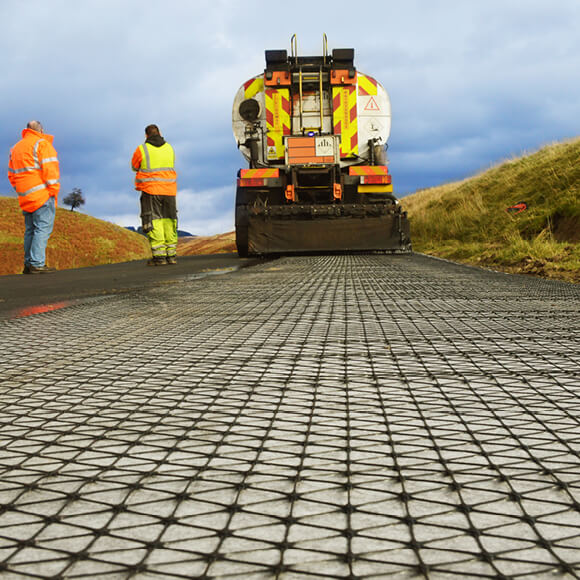
What causes road cracks?
Road cracks are caused by either repeated loading from traffic, or via temperature (climate) induced cracking. Over time, both types of external factors will cause the surface asphalt layer to crack, as well as the subgrade to become weakened in some causes, which can cause potholes.
Let’s take a closer look at these two causes of road cracks:
Load-induced road cracks
Load-induced cracking is caused by repeated loading from traffic: either fatigue cracking or reflection cracking (read on to learn about these types of road cracks). Inadequate structural design or poor construction can also be contributing factors, which is why the source of the cracking needs to be investigated before deciding on a sustainable solution.
Non-load-induced road cracks
Non-load-induced cracking is generally thermally induced and is referred to as low-temperature cracking, also known as freeze-thaw weathering. Here, the pavement shrinks at lower temperatures, generating tensile stresses in the asphalt, which lead to transverse (across the road width) cracking. Another form of non-load-induced cracking is associated with the presence of expansive clay subgrade soils. If these soils dry out, they shrink, causing longitudinal (along the road) cracking in the road surface.
Types of road cracks
The FHWA Distress Identification Manual identifies seven different types of road cracks:
- Fatigue (alligator) cracking
- Block cracking
- Edge cracking
- Wheel-path Longitudinal cracking
- Non-Wheelpath Longitudinal cracking
- Transverse cracking
- Reflection cracking
Fatigue (alligator) cracking
Fatigue cracking occurs when a group of interconnected road cracks form to break the road surface into multiple irregular-shaped pieces, usually less than 500mm in size. Due to its scaly appearance, it is often referred to as alligator cracking.
The main cause of this type of cracking is repeated loading, which causes incremental damage that manifests as a micro crack. This micro crack is initiated predominantly from the bottom of the asphalt layer. The road crack then grows until it extends through the full thickness of the asphalt layer..
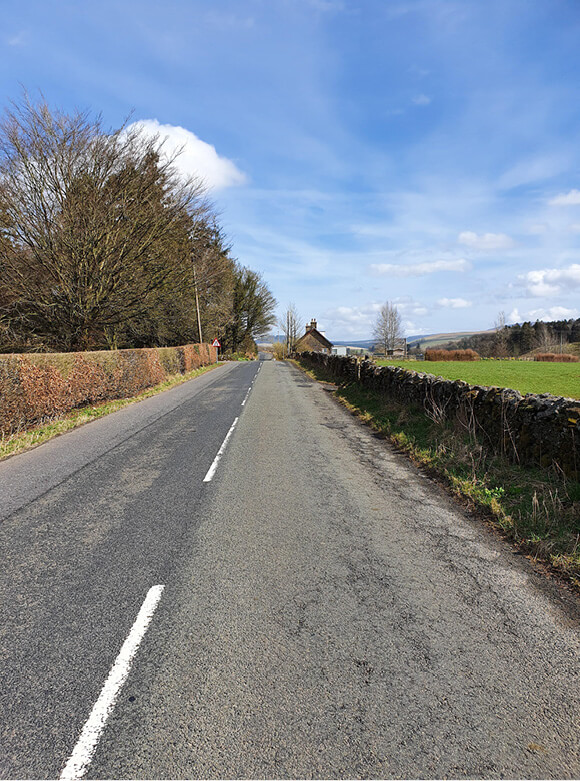.jpg)
Moderate alligator cracking in wheel-path
.jpg)
Severe alligator cracking
Block road cracks
Block cracking is a pattern that occurs as a series of roughly rectangular blocks, ranging from 0.3m to 3m in size.
Poor aggregate ratios, poor asphalt binder quality, insufficient compaction during construction, the shrinkage of asphalt pavement in cold weather, or even filling roads with dried-out asphalt could all be contributing factors to this road cracking.
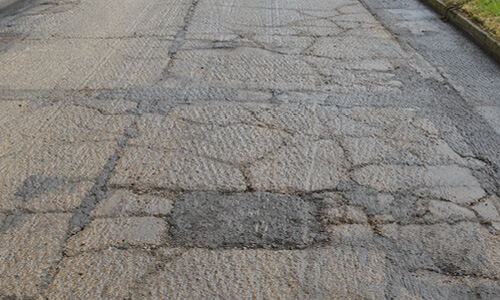-(1).jpg)
Severe block cracking
Edge road cracks
Edge cracking is long cracking in the outer 0.3 to 0.6m of a pavement that curves to the pavement edge. These road cracks can arise due to a lack of support at the pavement edge or else by erosion. Other factors can be poor drainage, which weakens the base and sub-base layers, causing the pavement to settle, or inadequate shoulder support, leading to edge instability.
Design techniques such as the use of flexible pavements fitted with asphalt interlayers can help to reduce the likelihood of edge road cracks.
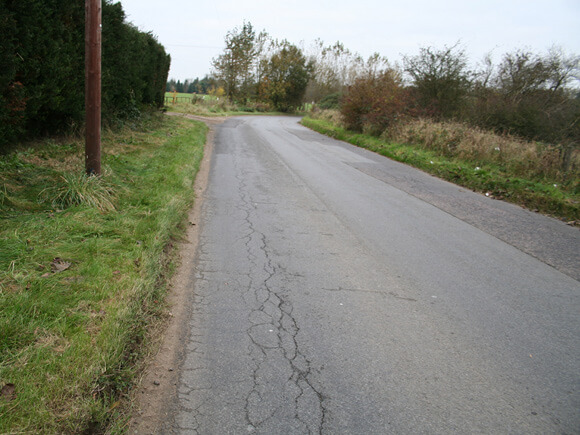.jpg)
Edge cracking
Wheel-path Longitudinal road cracks
Wheel-path longitudinal cracking runs parallel to the pavement's centreline, caused by fatigue. Other causes might include poor joint construction, subpar construction, or pavement ageing.
Non-wheelpath Longitudinal road cracks
Non-wheelpath longitudinal cracking is randomly located but still parallel to the centreline. These types of road cracks are predominantly created between the existing pavement and new widening but may also result from expansive clay subgrade soils.
.jpg)
Longitudinal cracking
Transverse cracking
Transverse cracking describes road cracks that are aligned across the carriageway perpendicular to the centreline. This type of cracking can be thermally induced or due to underlying joints or cracks.
.jpg)
Transverse cracking
Reflection road cracks
Reflection cracking describes cracking in asphalt overlay located in concrete pavements, or over shrinkage cracks in cement-treated base layers. It occurs over an existing crack in the underlying surface. This causes stress concentration in the asphalt layer that eventually leads to the initiation of a crack that extends up to the surface.
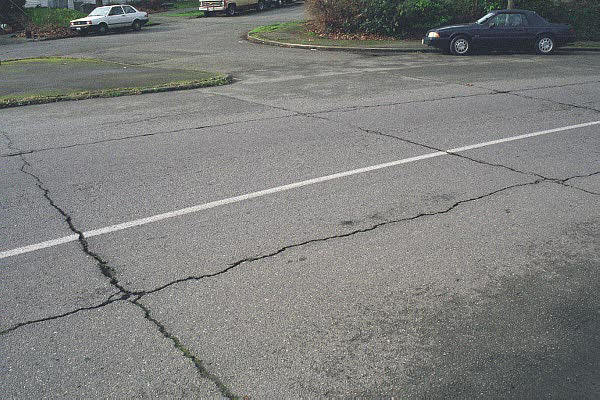
Severe transverse reflection cracking over joints in theconcrete substrate (Photo courtesy of Pavement Interactive)
How to treat road cracks
Treating road cracks effectively helps maintain pavement durability and safety. Common treatments include:
- Sealing cracks: Rubberised asphalt or sealants are used to stop water and debris from getting inside and causing more damage. This method is perfect for cracks that aren't structural.
- Crack filling: To fix less active cracks brought on by surface-level problems, you can apply a filler substance. This approach is economical for little repairs.
- Resurfacing or overlay: To make the road stronger and smoother again, road surfacing companies will often apply a fresh asphalt layer over the damaged area, which works for widespread cracking in particular.
- Patching: Take out broken sections and lay new concrete or asphalt. Ideal for big or badly decayed cracks.
- Base repair: Stabilise or replace weakened subgrade or base layers producing cracks to address underlying problems.
- Routine maintenance: Pavement life can be increased, and more deterioration can be avoided through routine crack cleaning and inspections.
To reduce long-term costs and improve the sustainability of road construction projects, the best solution is to prevent road cracks from occurring in the first place. Read on to learn more about how we can achieve this – or speak to our team to discover the role that Tensar solutions can play.
How can road cracks be avoided?
Tensar has a range of solutions for roads and highways to help prevent several types of road cracks including fatigue, reflective, and longitudinal cracking and extend your asphalt’s lifespan. Using the road design and construction module in Tensar+, you can prepare and evaluate the requirements of your project prior to construction, which will help you see cost and time savings.
Fatigue cracking results from repeated flexing of the asphalt pavement. The degree of flexure is dependent upon the structural strength of the pavement. Tensar stabilisation geogrids incorporated into the subbase or unbound base layer of a pavement increase the strength of the pavement, reducing deformations and fatigue in the surfacing. The fatigue resistance of an asphalt overlay can be improved by including a Tensar AX5-GN structural interlayer at the base of the overlay.
Reflective cracking in overlays can be delayed by the inclusion of an appropriate asphalt interlayer. Tensar has a range of asphalt interlayer products that have been proven to reduce reflective crack propagation.
A Tensar stabilisation geogrid in the unbound granular layers can prevent longitudinal cracking due to expansive clay soil. The geogrid controls the lateral movement of the unbound layers in the event of clay shrinkage.
Discover how we can help you make substantial time and cost savings on your next road construction project.
Request Design Assessment



